Dedication at Sangster’s Station
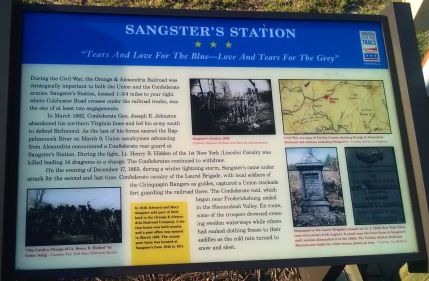
(Civil War Trails Interpretive marker located 1.75 miles from the original site of Stangster’s Station at Caboose Square in historical Clifton, VA. The original monument is at the lower left, with helpful maps and an account of the two actions at the Station in 1862 and 1863, All Photos Socotra).
Steve, the new member of the Historical Preservation Committee with the speaking part, got the Confederates and the Union forces sort of mixed up in the middle of the narrative about the raid on Sangster’s Station, but it was OK. The audience listened with rapt attention in the nave of the Presbyterian Church just up the hill from where the Devereau Station had been located at the time of the war.
The actual site of the raid was just up the track about a half-mile, but you know about the long bitter struggle between the Civil War Trails people and the Virginia Department of Historical Resources People.
They talked about it in the dedication ceremony, the one in which I wished there had not been a delightful bottle of wine with the splendid food at the Clifton Main Street Pub. I resolved, not for the first time, that wine should follow ceremony, not precede it, but sometimes circumstances get away from one, don’t they?
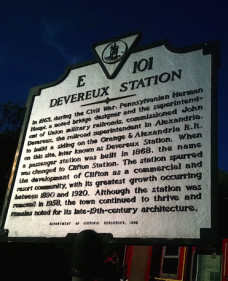
(The iconic shape of the VDOT-approved historical marker that could not be placed close enough for the Preservation Committee to the actual Sangster Station.)
Anyway, the Historic Resources people insist that the aluminum signs be placed on public roadways where they can be seen, and the nature of the old farm lanes that lead to Clifton are such that the sign would have been placed out by Ox Road someplace and make the history be divorced from the location, which didn’t seem to make much sense to the Clifton Historic preservation Committee, or at least to Margo, the chairwoman.
“It is a problem with the VDOT connection, the agency that installs and maintains the signs,” she sighed with disappointment. “The only place they would accept us putting the sign is just too far away from where it happened.”
The Civil War trails people are much more accommodating, and putting the informational signage at Caboose Square, even if it was not the right place, seemed to be a fair compromise, and matched it with the sign describing what happened in the actual place where the Devereau “Wye” had been placed in 1863 so the trains could turn around to head back to Union-occupied territory. They could not run further south due to the presence of hostile forces whose irritation with the Yankees was palpable.
But maybe I am getting a little ahead of myself, and need to back up to the drive in the rain out Braddock Road from the Beltway, and past the place I used to live, and to Ox Road and then the spur off into the old farm lanes that wander past St. Mary of Sorrows Catholic Church, on Fairfax Station Road. The little wooden church was the first Catholic Church in Fairfax County, dating to 1860 and the influx of Irish railroad workers.
Clara Barton, founder of the Red Cross, tended to wounded soldiers in the churchyard there, and the memory inspired her to create the organization.
Then past Fairfax Station itself, a modest little structure with a red caboose on the siding out front that I had never seen before, even though I had lived within a few miles of it for more than a decade.
The railroad my ancestors helped build stayed to the right as the narrow blacktop swirled over hills and followed the terrain. The increase in population with the explosion of development in the County had greatly increased the number of teenaged drivers, who demonstrated an alarming propensity for driving too fast and launching themselves into the trees. Accordingly, the Clifton cops are death on speeding.
In fact, traffic accidents were one of the deadliest things out in this very peaceful country place. Much more deadly than the rumors about the Bunny Man murders at the Bridge, which didn’t actually happen, though the vehicular mayhem was quite true.
When I rolled into town the rain was starting to subside, and the re-enactors of the155th New York Infantry Company I were emerging from their tents and beginning some close order drill for the entertainment of the crowd. David, their Captain, sported a period-authentic long goatee and spectacles under his Kepi, and wore his Colt .44 black powder pistol and Officer’s sword with panache.
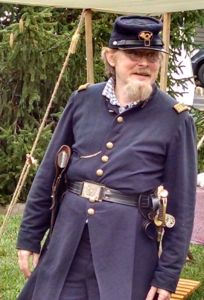
His men fired a couple volleys from their Springfield rifles to the delight of the crowd and it was a grand prelude to lunch in the Main Street Pub and that superb bottle of wine. I can’t recommend the place highly enough. The old general store and Texaco station retained the front end of the old store, but the back has been blown out to accommodate a cozy restaurant and bar. The staff was attentive and fun, and did I mention the wine was delicious?
And then the dedication ceremony, of course. The rain had caused them to move the speeches inside, though the skies were starting to clear as the crowd thronged in. The actual ceremony was delayed, and the musical prelude by Mandolin Jon was extended. You know the stuff he played- Ken Burn’s music from the historical documentary- and the reason for the delay was travel problems on the part of the 17th Virginia Infantry “Fairfax Rifles” re-en-actors.
They did not feel the ceremony should go forward with only the Yankees present. It didn’t seem right.
When the Butternut-clad troops arrived (no provocative stars and bars, only the regimental and State flag) we got rolling with a heartfelt rendition of the Anthem (very near the two hundredth anniversary of the penning by Francis Scott Key over in Baltimore) and a speech by State Senator George, an amiable fellow with orange hair, and a courtly presentation by portly Mayor Bill. Then Captain Dave gave us a brief history of the Buffalo, NY, Irish regiment that had guarded Sangster’s Station that perilous night, and Preservation Committee new-member Steve and his somewhat boggled account of the running gunfire in the storm and darkness, and some marvelous remarks by Chairman Margo with a stirring summation on what happened to the original memorial by the Fairfax City Historian Emeritus Lee.
The plaques had been stolen- preserved?- by a long term resident. “We did not treat it as a law enforcement issue,” said Lee with a smile. “But we knew he had them and approached the family after he died. He gestured at the square bronze markers that had been mounted on the low granite marker behind him. “All’s right in the end.”
Which it was. I wasn’t quite yawning by the time everyone had spoken their piece. Wine after ceremonies, I reminded myself, but was impressed by the level of effort and commitment on the part of people who have lives beyond preserving history. They were all nice people, even the politicians.
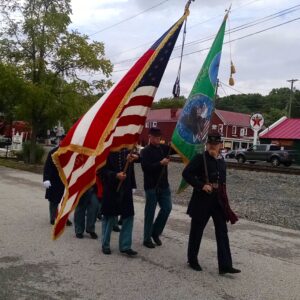
When it was done, we straggled down the hill as the 155th NY Infantry held their banners high. Photos of the Civil War Trails marker were taken with the political folks and the re-enactors in this pleasant little town where history is valued, and time seems to have stood completely still.
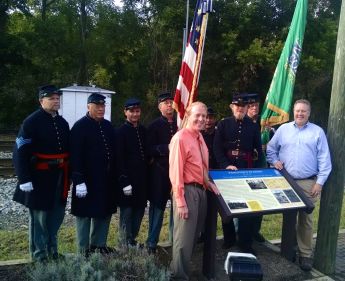
(155th NY Infantry, Co I, State Senator George and Hizzoner Mayor Bill.)
Copyright 2014 Vic Socotra
www.vicsocotra.com
Twitter: @jayare303
